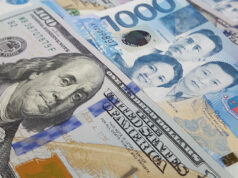By Christine J.S. Castañeda, Senior Researcher
YIELDS on government securities (GS) saw mixed movements last week as investors await the central bank’s monetary policy rate action and as the market priced in trade war concerns between the US and China.
On average, GS yields — which move opposite to prices — were down by 4.53 basis points (bps), data from the Philippine Dealing & Exchange Corp. as of Aug. 3 showed.
“In general, the market has been anticipating the ‘strong response’ by the BSP (Bangko Sentral ng Pilipinas) and rein in inflationary pressure,” said Ruben Carlo O. Asuncion, chief economist of UnionBank of the Philippines. “A more hawkish BSP is pushing yields down as the market waits for a monetary policy rate action.”
For his part, Land Bank of the Philippines (LANDBANK) market economist Guian Angelo S. Dumalagan said: “GS yields fell [last] week due to renewed concerns over the trade war between the US and China, with both countries threatening to impose more tariffs on each other.”
“There was also some market reaction to the BoJ’s (Bank of Japan) dovish stance, which was contrary to hawkish expectations of some tweaks to the BoJ’s target yield for the benchmark 10-year bond,” Mr. Dumalagan added.
Last month, central bank Governor Nestor A. Espenilla, Jr. said that the BSP is considering a “strong follow-through” policy action at its Aug. 9 meeting to temper rising inflation.
Meanwhile, on the external front, US began imposing 25% tariffs on $34 billion worth of Chinese goods last month. US President Donald J. Trump threatened doubling tariff on additional $200 billion worth of Chinese imports.
In the secondary market, the short-end of the curve saw yields on the 91- and 182-day Treasury bills (T-bill) drop by 3.64 bps (3.2409%) and 4.92 bps (4.2014%), respectively. On the other hand, yield on the 364-day T-bill climbed 4.48 bps to fetch 4.8685%.
In the belly, yields on the two-, three- and four-year Treasury bonds (T-bond) rose by 0.29 bps, 0.93 bps and 4.82 bps to 5.0456%, 5.1220% and 5.9839%. Meanwhile, the rates of the five- and seven-year bonds lost 22.91 bps (5.9048%) and 6.67 bps (6.2333%), respectively.
At the long end, 10-year T-bond saw its yield go down by 20.00 bps to 6.4500% while yield on the 20-year tenor was up by 2.32 bps to 7.4750%.
Going forward, LANDBANK’s Mr. Dumalagan said: “[This] week, yields are expected to rebound after [last] week’s unexpected drop. Main drivers include bets of higher inflation readings from the Philippines and the US, upbeat Philippine GDP (gross domestic product) growth as well as expectations of another rate hike from the BSP.”
“Trade concerns may continue to temper the increase in GS yields,” he added.
For UnionBank’s Mr. Asuncion: “I expect the market to wait and position themselves as the BSP is expected to increase rates [this] week.”
Official second-quarter GDP data will be released on Thursday by the Philippine Statistics Authority while July inflation figures will be reported tomorrow.
BusinessWorld poll of 15 economists and analysts yielded a median GDP forecast of 6.8% for the second quarter.
On the other hand, a poll among 14 economists yielded a 5.5% median inflation estimate for July, in the middle of the 5.1-5.8% estimate range given by the BSP Department of Economic Research last week.



